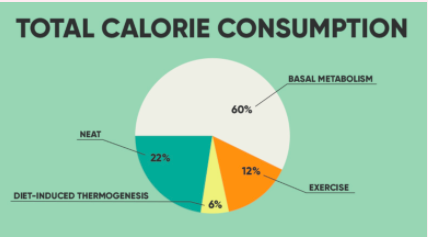a NEAT way to get fit – and it doesn’t include burpees…
"Siri, define NEAT."
neat:
1. 1.
arranged in a tidy way; in good order.
"the books had been stacked up in neat piles"
N.E.A.T.
1. 1.
Non-Exercise Activity Thermogenosis
"the exercise we expend for everything we do that is not sleeping, eating or sports-like exercise."
We are all aware that a consistent exercise program combined with a healthy diet can help us shed weight and achieve our fitness goals. However, what you may not be aware of, is that you do not need to push yourself to the max, sweat bucketloads and eat in a highly controlled manner to achieve it.
What Is N.E.A.T.?
Non-Exercise Activity Thermogenesis (NEAT) is the energy expended for everything we do that does not include sleeping, eating, or exercise; and ranges from simple things like standing and fidgeting to moving about.
Exercise alone is often not enough to keep the pounds from piling on. Essentially, when we move around in a busy job or make time to move more, even if we have a sedentary role, we will increase the calorie burn through NEAT. To compare NEAT, there is also E-T: Exercise Thermogenesis, which is where we burn energy through physical exercise. The combination of the two is really quite lovely, a nice synergy if you would ☺
Many small movements make a big difference in total. The percentage of calories per day burned through NEAT is different for everyone, but on average it's between 15% and 30%. The higher your NEAT, the higher your total calorie needs.
Other than helping us to shed some pounds, NEAT contributes to other health factors influenced by our physical health, since it increases our metabolic rate.
Movement truly is medicine.
As you can see, NEAT is working with a few different processes, which all count towards your daily energy expenditure.
1. Basal Metabolic Rate (BMR)
Your basal metabolic rate refers to the calories the human body needs to maintain all its essential functions – without moving. This includes, for example, breathing, maintaining your organs, and supplying your muscles with nutrients. That’s why your BMR usually goes up as your fitness improves.
2. Thermic Effect of Food (TEF)
This kind of thermogenesis includes all the calorie expenditure that comes from eating something. Sounds contradictory at first, but you have to process that food somehow, and that also requires some energy in itself.
Food needs to be broken down into its individual components, nutrients must be transported to their destinations, and anything superfluous has to be eliminated. This process requires energy and therefore you burn calories alongside your energy intake.
FYI: Protein has a higher thermic effect than other macros. So if one of your goals is weight loss or fat loss, pay attention to your protein needs. Getting enough protein despite a calorie deficit also helps prevent muscle loss.
3. Thermic Effect of Activity (TEA)
Deliberate exercise has an obvious effect on your energy balance, so you burn more calories on workout days than on rest days. Intensive H.I.I.T units, in particular, also keep your metabolism boosted through the after burn effect.
How to IMPROVE NEAT
It is all well and good to do 5 workouts a week, go to yoga etc. But what we do in between these sessions also is a huge contributor to energy expenditure. Energy expenditure contributes to being in a calorie deficit, which is what we need to be in to lose weight and keep it off. You may think that to burn more energy you have to only hammer yourself in hiit sessions, but this is incorrect, and unnecessary. In between exercise, our daily activities and choices contribute to our NEAT – and we have suggested some ways to improve yours, so that you can boost your body’s natural ability to burn energy through ‘rest’.
SEDENTARY ALL DAY = LESS ENERGY EXPENDED = WEIGHT GAIN
CONSISTENT MOVEMENT THROUGHOUT THE DAY = MORE ENERGY EXPENDED = WEIGHT LOSS/ MAINTENANCE
If you train later in the day, go for a walk before or after
Instead of driving to the café on the weekend ride your bike or walk to one closer.
Take the stairs at the shops instead of the elevator.
Stand more – Maybe suggest a casual musical chairs one lunch….
Playing with your kids - even though they're probably not neat...
Completing some garden chores- and no, watering the montserra next to your desk does not count.
Grocery shopping - maybe do this one without the kids. Stress induced NEAT does not sound as fun.
Cleaning the house; come on, does no one else secretly like it?!
Offer to make the coffee/ tea/ get people water at work!
Drink more water… go to the toilet more…
Multiple toilets at work/ school? Choose the one further away
Walk to a co-worker’s desk instead of emailing or calling them
Pace while talking on the phone
Set up walking meetings at work
Speaking from recent experience, buying a fitness watch can truly help increase awareness of and actionable NEAT. I gave my Garmin to my boyfriend when he got me an Apple watch. He is an accountant and sits all day at the office. Upon getting the Garmin he has been made aware of his poor step count (<2000 a day) when he simply goes to work and does not make the effort to do anything like the above. Having the watch means we are actually having conversations like - “nope gotta move, I haven’t reached my step count for the day!” It's great!
He now aims for 8-10k a day.
On the other end of the spectrum, us trainers will be looking at 15-20k+ on a work day! And we aren’t even trying - we’re just running around telling you lovely ladies to do another burpee hehehe (thank you ;))
So, our challenge to you this week, is to track your steps and aim to increase your NEAT. Choose one or more of the above activities, and implement them into your daily routine! We bet you’ll feel more energised.
X O X O




